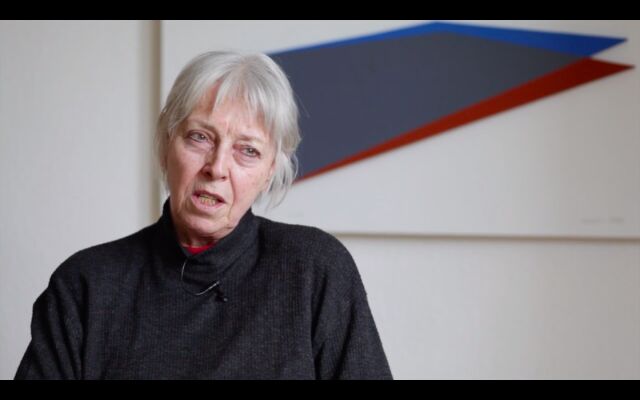One should always work with forms that are clear and not blurred...
Interview with Dóra Maurer, part 1
It is always fascinating to be able to trace the development of a career back to certain life events and experiences which have impacted its course. In this case, I was interested to find out what events and attractions shaped Dóra Maurer’s choices as a result of which we now have standing before us an artist of exceptional influence and her internationally relevant art.
Tünde Topor: I would like to start from the very beginning, from your childhood so that we can find out what influenced you, what is rooted in what. Or is this even relevant, in your opinion?
Dóra Maurer: Yes, it is. I think that a career should be looked at as a whole: how it started and how it continued. From this perspective, it is important to mention that my mother’s family had no links to art. We lived with my aunt in a residential building. There was a large painting at my aunt’s, hanging on the wall in a blondel frame, depicting an autumn forest with a few sheep. I occasionally looked at it and wondered how it was made. My father’s family came from Sibiu in Transylvania, so they were of Saxon origins. As a child, I didn’t know any of them, I met them only much later, and only superficially. I didn’t know my father; he died before I was born. He was 47 – you might say he was old considering he had a baby on the way. In World War I, he was captured – and then managed to escape – more than once; he developed a stomach ulcer. When he found out that he was going to be a father, he quickly decided to undergo surgery – which cost him his life. My mother was 38 years old when she married my father, so she was not exactly a young girl either. My father died in January and I was born in June. My mother spent the time between these two events weeping, so I had a lovely cradle in her womb (laughing). My father was a cartographer and surveyor, and also an amateur painter and drawer. In our flat, tiny, framed aquarelles were hanging on the walls; some depicted Budapest landmarks like Margaret Bridge and the Parliament, and there was one that depicted some kind of hideous sunset. He also had a secessionist-style drawing, very intricately detailed with an ink pen, which inspired awe in me for its precision and beauty. And I think it is also important to mention that our flat was filled with furniture designed by my father: armchair, kitchen cabinet, those kind of things. The kitchen cabinet had a wonderful scent, partly because it had a good veneer and had been polished with all kinds of varnish, and it was filled with things my father used for his cartography work: strange, tiny, feather-shaped scraping things, Chinese ink sticks, and all manner of curiosities. Later – but still quite early on – I began to examine and look at these objects. And, concerning my own drawing, when I was very little, there were Christmas drawings. I remember, I had to give everyone something and we had a big family – my mother had a lot of siblings. So I copied things out of the books that were given to me – they were quite naturalistic but pretty and refined – and, on these occasions, I gave these drawings away. The drawings that were of my own invention – and keep in mind: this was during the war – had a central theme or thought that has remained a driving force of my activities ever since. In the centre of the picture there is house. It is a regular, gable-roofed house, there is even a dovecot to go with it, and it has a fence around it. It is axonometrically depicted, viewed slightly from above. Because I always had an interest in perspective – not frontality, but perspective. This house represented a perfect, happy life, when everything is harmonious. To the left and right of the house, there are rocky, mountain-like formations. On one of them, there is a cross and a wreath, with a tiny human figure kneeling in front of it. On the other side, there is a canon, which is shooting at this mountain opposite to it; so it is shooting at the person who is praying there. It is shooting not at the house, but at that figure.
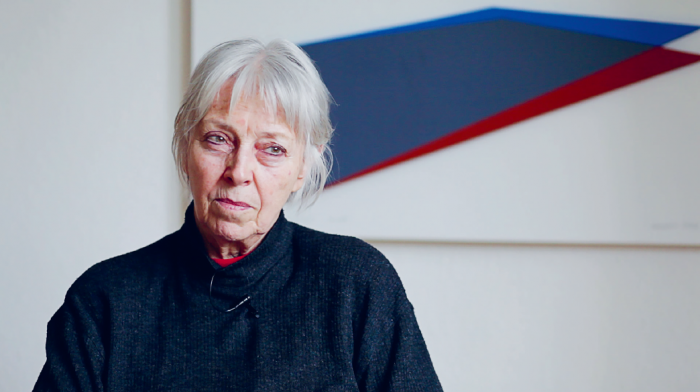
Recorded on april 4 in 2014 kat Dóra Maurer's studio
Interviewer: Tünde Topor. Video: Marcell Esterházy. Special thank to our interns for typing the interview: Bódiová Katarina, Réka Dankó, Anna Surján és Zsuzsanna Zsuró
The whole video is available at Artmagazin Online. © Artmagazin
My memories of the siege are difficult, but not tragic. Half of our house in Víziváros [Budapest city quarter which literally translates as “Water Town”] was bombed to ruins, while we were taking shelter in the basement. Iron doors were flying in the air. I was not afraid, I was more fascinated; we are walking in dark corridors and people are saying “careful: water from the right, soup from the left”. I had a new doll, which I carried around on a pillow. A woman saw it and yelled at me: “Put down that baby at once!” Strange things were happening. That was where I saw the first dead body – or rather: his shoes. During the attack, someone died, was placed in a tub and covered with paper. They said it was “manó” [Hungarian word for “elf”]. What they really said was “this is Mann úr” [Mr. Mann], but what I understood was “manó”, even if I was a bit old already for such a silly notion. So this was the direction my drawings were taking. I also drew soldiers even if I hadn’t really seen any. And then nothing for a long time, only drawings in school, like the one with the pliers, which György Olajos found a few years ago in an elementary school warehouse. I drew a lot in elementary school, I was the one in charge of making our bulletin board. I even tried to make a poster. In the meantime, I was also a swimmer and my swim coach Pál Peterd asked me to illustrate his poems. I also did the cover of the book The Three Musketeers, which I still have – it’s not too bad, but it’s, well, childish. It’s actually from the time I was preparing for the Secondary School of Visual Arts. We were a middle-class family, and, on top of that, my father had been a military officer, so my mother lost her widow’s pension as well. Although she had gone to work at the Rico Bandage Factory, doing three shifts (this was during the time of the Korean War), somehow it got out that I was not a child of the working class. This may have something to do with why they didn’t want to forward my application to the Secondary School of Visual Arts. Luckily, we found out about this before it was too late and my mother went and stood in front of the school on the corner of Lónyay and Török Pál Street and approached a man who was just exiting the building. This person happened to be György Z. Gács, the school director. She asked him how it was possible for a child to gain admission to the school. Z. Gács looked into it and discovered that, indeed, my application had not been forwarded to them. He recommended for me to attend the evening preparatory course. So there we sat in a large, badly lit hall, drawing still lives and stuffed birds. I couldn’t understand why others took so long to draw, say, a teapot. I was done in two minutes because I had primitive drawing skills and was not particularly interested in details and the various methods of creating a more intricate depiction. I had no difficulty getting admitted and spent most of my years as a swimmer there. In truth, it was not really painting or drawing that were interesting to me at that time. I enjoyed doing these things, but what was really at the centre of my focus was swimming. I was a record holding, youth-league backswimmer. I was enthusiastically attending swimming practice until I turned 18, although, during the last year or two of secondary school, I was thinking more in terms of becoming a historian or a forest ranger. My interest in nature can be traced back to something specific: the elementary school in Csalogány Street, where I had gone to school, had a large lower garden which had been completely neglected, with weeds growing waist-high. It did, however, provide children with a possibility of making their own little vegetable garden – which later became a mandatory part of biology class. I took care of it even in the summer, even during vacations. I even brought some frogs over from Margaret Island so that I could put them in my little pond. Of course they all died, the poor things. I loved to watch the plants grow. I experienced a feeling of happiness and this attraction stayed with me. I would also like to return to something from earlier, because it’s relevant here: I did a lot of copying from my German-published children’s books. One of the series, illustrated by – I still remember her name – Nora Scholly, portrayed the bucolic existence of German peasant children through incredibly intricate aquarelle pictures. They were frying potatoes, smoke was rising from the chimneys, there were mountains in the distance, and forests, there was the changing of the seasons. The depictions were very sensitively done, they engaged the imagination. This was not the style I adopted when I began creating my own drawings, however. What happened was, I received a magazine clipping from my swim coach which showed a tired boxer sitting in the corner of the boxing ring with his hands and head hanging down. I remember, it was a photo of a painting with brown and a darkish green – you might say foliage-green – colours. Peterdi asked me to paint it for him, which I set about doing with little success. I found paint and some cardboard. My cousin and her painter husband Erik Scholz had lived for a while at my aunt’s in a rather interesting room, half of which had been hit by a bomb. Although they had rebuilt the wall, there was no plaster on it – the raw bricks were a painterly sight. Then Erik Scholz moved his family elsewhere because he was given a studio, but he left his paints behind. They had all been pressed onto a glass plate, just left there for me to use – and so I did. I must have been around 13. After I painted the boxer, I began to paint the view from our window. We could see all of Víziváros and the Buda Castle because so many of the buildings had been bombed. I began to paint houses, with strongly defined black contours – which in retrospect could regarded as constructive. Then Erik came and told me that this was the simplest way, the easiest way. So I stopped doing it and moved on to naturalism, but only in the form of aquarelle – these are better forgotten. I am only telling you all these things, because I suspect the roots of geometry may have been somewhere here.
But as I said, in secondary school I was primarily preoccupied with swimming, and then nature-related activities. And I also developed a fondness for history. Nevertheless, I applied for admission to the Hungarian Academy of Fine Arts – I figured I wasn’t going to get accepted anyway. But I did. I even remember the drawing that got me in. László Lakner, who was a year ahead of me in secondary school, had a drawing that won him a prize and also got exhibited. It depicted a small, white nude in an immense, dark environment. The black was done with soft graphite in a way that made it feel like a colour. I found this captivating: black that is colour. It’s not merely tone; it is its own entity. This was what I managed to create in a portrait, in one of the drawings for my entrance exam. I was accepted into the Graphic Arts Program. Although Sándor Ék was our teacher, it was his somewhat boring teaching assistant who mostly worked with us. The models we drew with charcoal were also boring – they were almost exclusively retired female acrobats. They had hard, muscular bodies, but they were not men; I really didn’t like drawing them. If things had continued like that for much longer, I probably would have quit the whole thing. I still had the option of becoming an aetiological historian or finding employment at the zoo. At the beginning of my second year, however, I became interested in etching. An upper-year student coated a small plate for me and showed me the “hatching-like” technique of etching, where you take a needle and scratch many lines into the ground, haphazardly, in order to formulate something. But this learning process was interrupted by the historic events of 1956. To me, the breakout of the revolution was not sudden or unexpected; I lived in a reactionary family and it was obvious that the system, at some point, had to collapse. My mother even refused to put out our Persian rug from the better days, saying “not for these people”.
On the 23rd of October, the march to Bem Square electrified me, like it did everyone else. I really thought that, from then on, everything would be great. I later stood in front of the Parliament with great enthusiasm. Though even then, you could tell that there were some who approached the whole thing with an irredentist attitude. There was an old man next to me who was shouting things that made it very clear: he wanted the Horthy era back. But from the shouts of others I gathered that they wanted to repair socialism, to make it more “human”. And, in effect, that was what I thought it was all about, too; I had always veered a bit to the left. Then, during my travels abroad, as I experienced my own poverty and foreignness, I became ever more of a leftist.
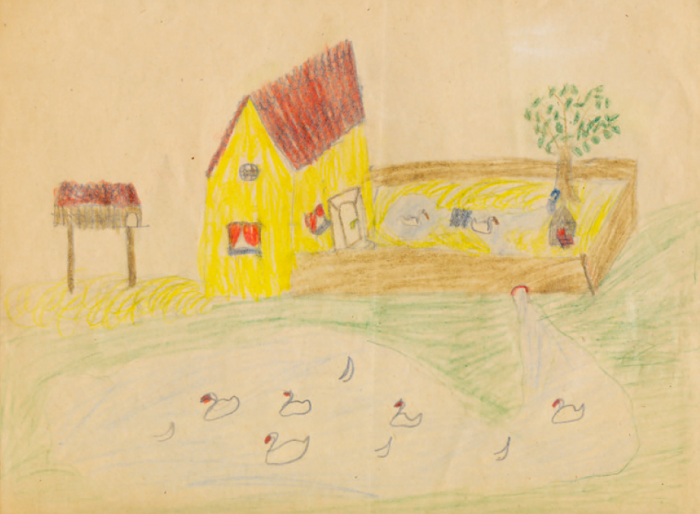
Dóra Maurer's drawing from around 1942, colored pencils on office paper, circa 210 x 290 mm © Maurer Dóra
When, as a result of the shootings in front of the Parliament, a great number of people were hurt, together with a girl from our house we went to care for the wounded. We went from one hospital to the next; we weren’t needed anywhere, except for the Honvéd Hospital on Róbert Károly Boulevard, where I spent two nights on my feet. By the end, I was caring for Russian soldiers. There were some horrific things. I was putting drugs in a cabinet when they brought in a young man who had part of his skull missing. I could see his brain. He was waiting to be X-rayed or operated on, and I had to keep telling him to stop moving so that his brain doesn’t fall out. I was frighteningly close to him. So ‘56 changed me. Until then, I was a naïve, open kid, but then I changed completely. I was not willing to speak, only sometimes, when it was absolutely necessary. I didn’t want to meet with people. I took the tram every day to Hűvösvölgy or Zugliget and went on long walks. I wrote prose and poetry, and I drew. I read all kinds of things. I cannot recall the specific books, but I think it was mostly Thomas Mann. I also read some Hegel. I even stole a copy of Hegel’s Aesthetics from the Academy’s library because it had such perfect reasoning; it answered a lot of my questions.
Then school started back again; I think it was in March or April that it was first possible to enter the building. The Graphic Arts Department was officially closed. In my second year, Gyula Hincz became my tutor; he engaged in political discussions with us. I still have to laugh when I think of him sitting in front of the window, animatedly gesturing, telling us he is incredibly optimistic and everything will be fine from now on. He was sitting on a three-legged stool and, as he was saying this, a big, animated movement send him flying to the floor.
There were some students in our class who thought it was a good thing that the revolution had been crushed. KISZ [Hungarian Young Communist League] began its operation; I didn’t become a member. The leader of KISZ, Gáspár Csoór, was actually a classmate of mine. He was an older, pensive man who read a lot. Nevertheless, I found it strange how he could identify with a state, in the process of solidification, which was ruining people and represented retortion. I developed a friendship with Vera Vásárhelyi, the daughter of conductor Zoltán Vásárhelyi. She had previously studied the cello at the Academy of Music. Tamás Vekerdy was her boyfriend. So it was through her that I met Vekerdy and their circle of friends, which, at that time, also included Gábor Karátson. Him I met when he had just been released from the Vác Prison. Ilona Keserü, Erika Ligeti, György Kovásznai, and János Major were in this circle as well. It was in ‘57 in Szentendre that I met János Major, who was making small etchings at the time. I really liked the pure, clean lines he was using. I was still greatly affected by my experiences of ‘56, and feeling very lonely. But, in Szentendre, I came back to life; I began creating dynamic, somewhat expressive landscape drawings. The purpose of these drawings was to make sense of the shapes of the hilly landscape; I interpreted those large forms based on one another. When I had to put them on display for group critique, someone in the class said they were rather intellectual. I didn’t feel at home in any of the classes at the Academy, so I walked from room to room. If I saw something interesting somewhere, I sat down by the bottom of the easels, and created small drawings with extremely tense forms and emphatic features – I still have these somewhere. Later I made things easier for myself by taking whoever was the current model at the Academy home with me. During this time, I earned some money with small jobs. For instance, I created the decorative panel for the window of a hairdressing salon. At home, I paid form my own room in order to help my family’s financial situation at least a little bit. At school, instead of attending theoretical lectures, I drew portraits of the cleaning woman, the furnace operator, and my classmates. There was a cleaning woman who, after seeing my drawing, never said hello to me again. Well, yes: if someone had beady eyes then I had to accentuate that. I only did drawings, no paintings. In effect, you could say that what really interested me was capturing what I saw in a robust manner by concentrating expressly on forms. Which can be brought into connection with the bitterness I felt after the crushing of the revolution and the animosity I felt towards people in general.
When, in my third year, I naively put up my works, I was told that if I continued like this till the end of the year, I would be kicked out. That was when I began to work along two separate tracks. I went to school and I painted on a canvas, like everyone else, in a simplifying, postimpressionistic manner – as we referred to it back then. And, at home, I did my own thing. I remember, there was a call announced at the Academy for depictions of the workers’ movement. I created a three-part etching series – a triptych – in which I portrayed all my acquaintances, including Gyurka Nagy, Miklós Melocco, Vera Vásárhelyi, Jancsi Mayor, Klári Deák, as well as cleaning ladies, a model, the furnace operator and everyone. In the first sheet, they sit around a table engaged in a debate about how the movement should be started. But in the background, there is a figure lurking, listening to the whole conversation. The second part depicts a scene of revolution, where a huge crowd attacks a single, unfortunate policeman on horseback. In the third sheet shows the moment of retaliation, and, through a window, we can once again see the figures from the first sheet conspiring. I traced these compositions back to basic geometric forms, like Béla Uitz’s constructionist drawings for his Luddites series. I drew my inspiration from many different sources: Van Eyck, Hodler, Modigliani, Schongauer, Lucas van Leyden – having only seem reproductions, of course. At the Museum of Fine Arts, Sebastiano del Piombo’s Portrait of a Man was the only exhibited work I liked to look at because I enjoyed its harmony. The primitives, like for instance Konrad Witz, appealed to me more in the form of tiny grey reproductions. I was haunted for a long time by Lucas Cranach the Elder’s painting entitled Fountain of Youth, and have been, even in the past five decades. In the middle of the painting, we can see a large, perspectivally depicted pool, in which ladies are bathing and regaining their youth. Their husbands are carrying them to the pool in carts and wheelbarrows. The husbands remain old, while the youthful maidens are awaited in the bushes by young lads so they can make love. It was this pool and its colour as I envisioned it – because I only saw a small, grey reproduction of this as well – was what really captured my imagination.
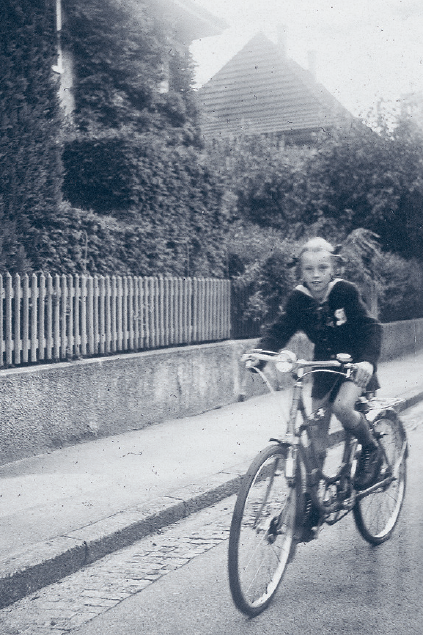
Dóra Maurer in the summer of 1946 in Olten (Switzerland) © Dora Maurer
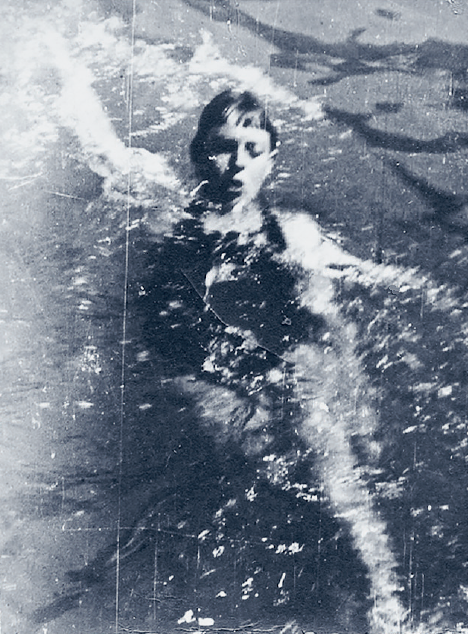
Summer 1956, Tata (at the college of artists in Tatabánya) © Dóra Maurer
Every year I spent some time at the artist colonies of the Academy. I went to the one in Hódmezővásárhely twice, I am not sure why, maybe because it was really hot there so that I could suffer. I spent the whole time riding my bike and drawing the people in the market in that same fashion, which I referred to as “thoughtful”. When, at the end of the artist colony period, our works were presented at the Tornyai Museum, a teacher who was also the wife of our head tutor at the time, wrote in the guestbook: Maurer has a brain but not a heart. This really crushed me and, from then on, I tried to ease up a little. I had an etching, for instance, entitled Like Pearls, because I regarded each figure in it as a characteristic entity and placed them next to one another in way that preserved their autonomy; I was growing fond of them. Shortly after, it was the beginning of the diploma year. Since I was a student of the Graphic Arts Program, I created a series of etchings depicting everyday scenes and personal experiences. I gave them the title Everyday. This innocent, friendly series did not earn me a diploma. Everyone around me was granted one. The committee consisted of Nóra Aradi, Sándor Ék (whom I didn’t want to meet with for an entire year because I was afraid he would interfere with my work), György Kádár and Aurél Bernáth. Students of the latter had passed the diploma exam the year before in spite of their working style, because he helped them pass. By the way, if anyone, it was them that my work could be brought in association with: Ákos Szabó and Lakner, along with his predecessors – Hantai, Csernus, and certain American artists, including Ben Shahn). I was not inspired directly by these great figures – not even Csernus, who lived in Budapest but never exhibited his works. Nor did I frequent the Fészek Club either to leaf through their journal collection. Somehow it was in the air: because this was the message I got even from Hodler, and especially Modigliani. That is to say, the need of rounding off, emphasizing, sensing the importance of the body, and the sharpness too – that one should always work with forms that are clear and not blurred, always taking into account the quality of the material as well.
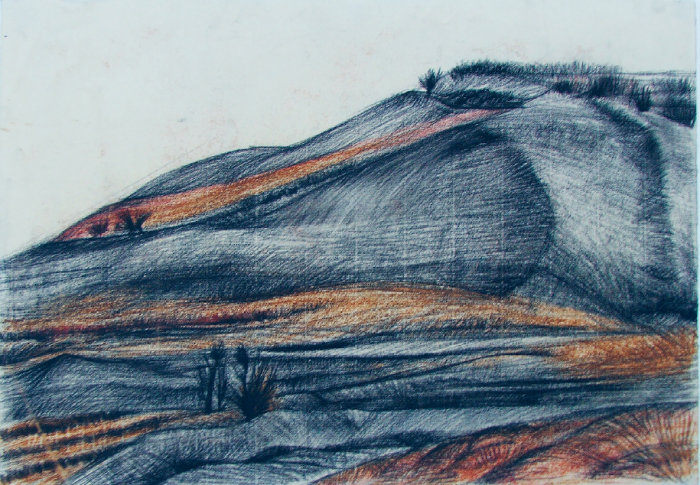
Dóra Maurer: Szentendrei dombok (Hills in Szentendre), 1957 summer, chalk, Ingres-paper, circa 250 x 400 mm, private ownership © Maurer Dóra
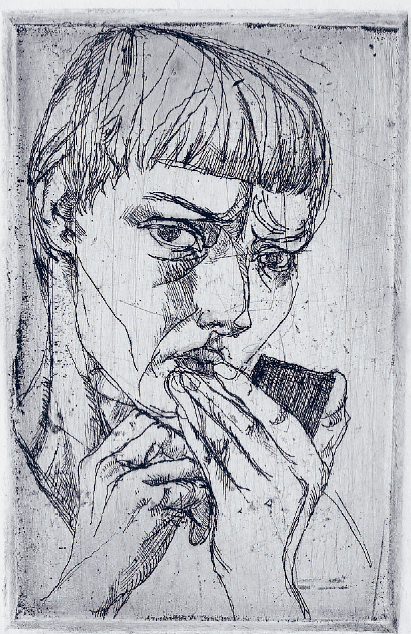
Dóra Maurer: Selfportrait, 1957, etching, proofing, 120 x 70 mm © Maurer Dóra
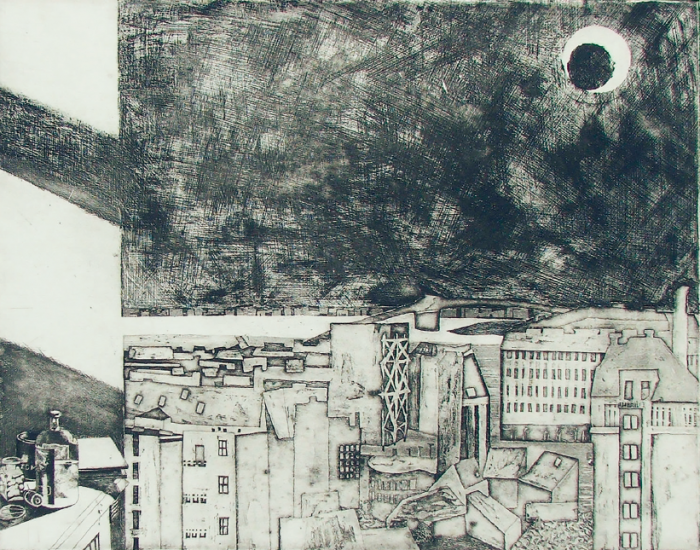
Maurer Dóra: Napfogyatkozás (Solar eclipse) (from the Everyday series, diploma work), 1960, etching, 168 x 215 mm © Maurer Dóra
But you were not given a diploma.
No, I wasn’t, which was quite strange. I was worried about the consequences, especially about my mother finding out; all her life she had expected her child to become a drawing teacher. She was going to think that all my years studying at the Academy were in vain. But those six years determined the course of my entire life. As soon as I started at the Academy, I didn’t only lose interest in swimming, it also became impossible to practice, because I was busy all day long and by the time I managed to make it to the pool it would be filled with civilians or water polo players. And actually, as a swimmer, that was when I was on my best form. So no more sports for me. But, to return to the issue of the diploma: the three teachers called me and Sándor Ék said: I’ve already told you this was a dead end, this should come as no surprise. György Kádár asked me if he could buy my diploma work, because he felt this would help things. Bernáth invited me to the Lukács Patisserie, and while I could order delicious cakes, he told me that I was a victim of “judicial murder”, and if I needed anything, I should let him know, he would help. Well, I didn’t take him up on his offer, but I didn’t really get into any trouble either. Shortly after Képcsarnok Vállalat [Gallery Company] commissioned me for a job; back then becoming a member was somewhat automatic and they made sure that there was work for us. My first commission was a postcard-sized etching of a beautiful building in Museum Street. I made a living off these Képcsarnok jobs for a quite some time. I received three or four commissions per year, which I could do a good job of fairly quickly. I travelled a lot for this type of work, from Sopron to Rudabánya. I was either given photos or I took the photos myself, on which I could then base my etchings – which were then used for practically nothing. They were printed in the hundreds, but I heard that when the rooms of the commissioning companies were renovated, they used these prints to protect the floors from the paint. So it was a senseless thing, but it provided us with a living, and I was amused not only by having to hitchhike all over the country – to places I never would have travelled to otherwise – but also by using techniques which, for various reasons, I would not have used – or would have only used with caution – in my own, real work. For instance, I heard from my uncle who used to also do some typographical work that if you place the plate into the ferric chloride with the drawing turned downward, it will speed up the corrosion process. To this I added my own observation: such flat etchings come to have ice crystal-like serrations; a process of crystallization occurs on the unprotected surfaces, as the grains of copper that are “bitten out” by the mordant fall away. I worked at home, even got my own etching press; at first I had a mangle, then I got one that operated with a proper metal cylinder. I used the bathroom to work with the acid (sometimes nitric acid as well), which then all flowed into the Danube – I had no environmental awareness back then.
And you travelled alone as well?
Always, yes. There were a few times when the agent who got us the job piled us into his car and took us to the scene. But usually I went alone, and I got where I needed to go by hitchhiking. Once, for example, I got to Sopron in a transport vehicle of Sopronkőhida Penitentiary. It was raining and a grey Pobeda showed up with two guys in it. They started asking me questions, where I was going, what I was going to do there. And because I got the name wrong of the director of the mining museum I was going to, they enquired after me to make sure I wasn’t a defector.
What kind of social life did you have back then?
Since my years at the Academy, my social life involved the people that I’ve previously mentioned. With them, we went to concerts almost every day, and we also snuck into the Academy of Music. In the meantime, there were all kinds of parties, in the Chatel family’s home, at Ilona Keserü’s place, one time at Major’s, but never at ours; our place was in no shape to receive guests because we always had tenants. This was the time when Sviatoslav Richter began coming to Hungary. We went to every one of his concerts and snuck in. Once I was lying under the stage at the Erkel Theatre, just under the piano, and it was from there that I listened to Brahms’ Piano Concerto. At first, I ran up to the top gallery and then took a different path down, and suddenly I found myself in the basement. The concert had already started, and I could hear it from very close, so I stayed there. That was also the time of the Liszt Piano Competitions. They were excellent productions; the same piece was performed in different ways. I remember Lazar Berman especially well. We listened to every single concert, regardless of whether it was before or after noon. When I was a child, I took piano lessons for six years, but I quit because I found practicing to be too mechanical and I didn’t have a teacher who helped me develop a sensitivity to music. She was more focused on developing my playing skills and creating moods through music – an approach that I had no interest in. Later, when I was already in secondary school, I turned more and more toward music. I still have this affinity, although these days I rarely listen to music, because I don’t like mechanical music and I rarely go to concerts. But back then I listened to a lot of music; I built up quite a record collection. László Végh was connected to our social circle of that time. He was originally a radiologist who was also a new music enthusiast. He was our only acquaintance who had a tape recorder so he could record material from the New Music Days in Darmstadt, and then let us listen to it. This was where we first heard pieces by Schönberg, Webern, Boulez and Nono. Laci Végh was also a great musician; he improvised Wagner for us from orchestral music score. He gave me a small book written in German that contained the text of two Webern lectures, and asked me to translate some of it. I got so excited that I translated the entire thing with the help of my pianist friend Mari Krause. An acquaintance introduced me to the director of the Zeneművészeti Kiadó [Music Publishing Company], and so this translation was published in ‘66.
‘63 was the first year we could travel abroad, which was something I had long wanted to do. I haven’t mentioned yet that I had three trips abroad as a child; each stay was three months long. The first time I travelled out of the country was in ‘46, when I was taken to Switzerland by the Red Cross. My mother had discovered that they had these child nutrition programs and very cleverly managed to squeeze me into one of them. I was horribly homesick, I longed for security and my mother, and who knows what else, and I constantly wanted to leave the good life and go back home. I wrote to my mother and told her if she didn’t take me home I would forget how to speak Hungarian and I began sending her letters full of spelling errors. My mother took it seriously, and began to worry. The second trip was much more interesting. I ended up in Denmark; the director of a large agricultural girl school took me in. It was an old married couple, their children were already grown and I became the “little sister”. The old man played with me all the time, chasing me around under the table. The woman was strict. We were surrounded by vast natural vistas, robust horses in stables, cows in the fields with an electric fence around them. There was a student presentation of Ibsen’s Peer Gynt, which was an important experience for me. I played with children – primarily Hungarian children – in the village. The institute was next to a village named Wallekilde. It was very far from the sea, but we travelled there too.
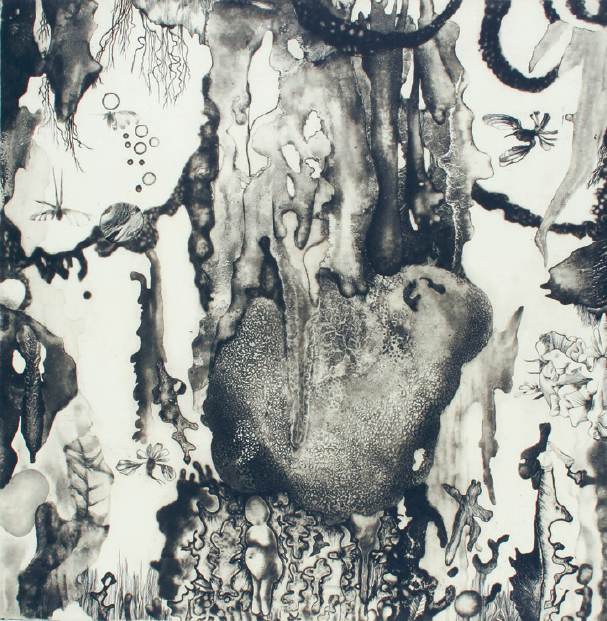
Maurer Dóra: Édenkert pitvarában (Pompeji series 3.), 1964, etching, mixed media, 290 x 290 mm © Maurer Dóra
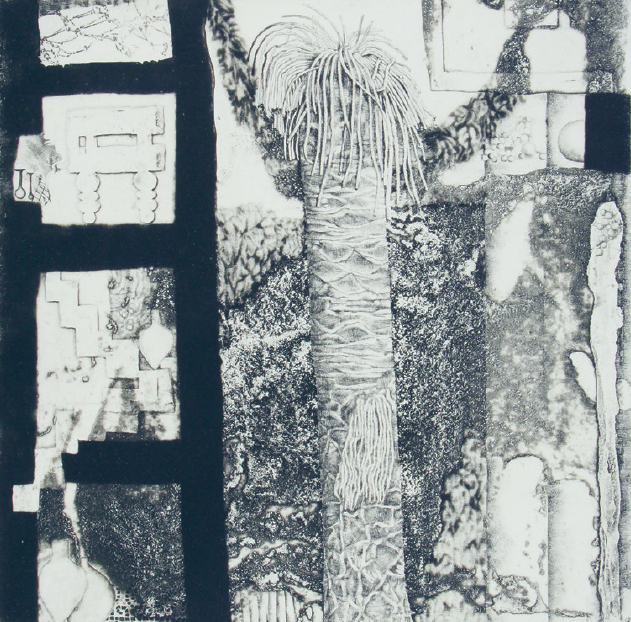
Maurer Dóra: Holtak háza (The House of the Dead) (Pompeji series 1.), 1963, etching, mixed media, 168 x 160 mm © Maurer Dóra
And what year was this?
I was ten years old then, so it was in ‘47. And I was completely free there. We had breakfast at nine, lunch at one, then bedtime at nine. I tried to bring home a cat, but they threw him out. And I told on the boys who had caught a thrush in the chicken coop. They tied it up and spun it around on the rope so that its head kept smashing on the wall. I was outraged and I went to tell on them, but then felt ashamed. So I learned many lessons in those three months; I barely even wrote home. My mother later asked me why I didn’t send any letters and I told her it was because I was too busy horseback riding. Of course, it was only wishful thinking, but she took it seriously and asked if I had ever fallen off the horse? Of course, headfirst into the stream – and things like that. My third time abroad was when I was 11. I spent time in Switzerland again and made sure that I stayed with the same couple that had taken care of me the first time around. That was also where I learned to ride a bike so I could go on big bike trips that the school had organized, for example, through the mountains to Southern Switzerland. It is also worth mentioning, that, when I was there, in ‘48, there was a national school drawing competition in commemoration of the 100th anniversary of the Swiss Railway. My drawing was also submitted along with my playmates’ material and, it just so happened, I ended up winning the competition. I was already back in Hungary, but, oh, the glory of it! I remember the drawing: it was a non-perspectival depiction of two cars of a green passenger train. In retrospect, its style was actually very geometric – quite simplistic. It’s interesting that this was what appealed to them; it clearly fell in line with Swiss visual awareness at the time, probably as a result of the Zurich School.
After that, I was only able to travel abroad as of ‘63, when I visited my Swiss “foster parents”, who, in the meantime, had taken in a little girl and a little boy. I went with them to vacation in Italy. Back then, passports were issued for a full year, but if you came home earlier, that was it – the passport expired. I spent three months abroad with a total of 70 dollars in my pocket. In Switzerland, I made a little money painting the floor of a basement with grey paint, and I was also given an allowance. We spent a lot of time camping in Tarquinia. In essence, they financially supported me during this time, albeit somewhat begrudgingly; they asked me to at least do drawings of the family. So, in the mornings, while the campground was still quiet, I pulled one of them out of bed and made a portrait. I said goodbye to them in Rome, but, before that, we had also visited Naples, Pompeii, and Herculaneum. In Rome, I had to stand on my own feet, spending 300 lire a day on lodgings and the same amount on food. My daily menu consisted of a sardine, a slice of bread, a cluster of grapes and a cup of coffee. I kept my luggage at the Hungarian Institute; the receptionist had allowed me to store my things in a locker opposite his booth. Otherwise, I was covered in filth; I only had one dress, which turned almost yellow. I lived in various places in Rome, there was, for instance, the flat of an old woman by the name of Katarina la Bella, with whom I shared a bed. Her home was full of birds. I liked staying there, because if I got hungry in the evening, a tenant who worked at the bread factory jumped on his scooter and brought me a few panini from the factory.
Did you speak any Italian?
Well, a tiny bit, yes. When they spoke at length, I could get an inkling of what they were saying, but there was not much I could say when they asked me how I was doing. I essentially spent the three months gathering experiences. For one thing, I reconstructed in my mind the history of art as I knew it from the books by visiting the Uffizi, and travelling though Siena and Venice. I was not interested in contemporary art; I only went to the Museum of Modern Art in Rome, where I saw the sculptures of Germaine Richier. In addition, I was soaking in the environment, the world of the Mediterranean. There was a possibility to purchase a rail pass valid for a whole month, which I could use to travel anywhere. So I more or less covered all of Italy, little by little, from Orvieto to Venice, and then back all the way to Brindisi, where I boarded a ship to Greece. I drew a lot and didn’t take any photos. I lived with nuns, for instance, in Siena, right at the time when they were holding the Palio. It was this group of experiences that I processed and added to in my later travels. I tried to travel somewhere every year. Later these one-year opportunities were not available anymore, and one you could only leave the country for shorter periods. In ‘65, I had my first small solo exhibition that showcased the etchings of Pompeii and my later experiences related to my travels to Yugosalvia and Greece. In the bookshop of Gondolat Publishers in Váci Street, there was a notice board with some room on it where I could put up three or four of my etchings. I put a drawn poster in the shop window (but I had forgotten to write the year on it). I had to give the opening speech for this exhibition-like event. And do you know who showed up? Anna Oelmacher with a fellow lady comrade, and a renowned physician-biologist György Kontra with his wife, Ilona Kozma, who was an older friend of mine. After the first sentence of my speech, I floundered, but they made a very gracious audience. I had gotten to know Anna Oelmacher because she lived at the beginning of Bimbó Street and I lived in Szász Károly Street, so we got on the tram at the same stop, often at the same time. Then, when I started to say hello to her, she enquired who I was, what I did, and we ended up in friendly conversation for the duration of three or four stops. There was also a memorable event linked to this acquaintance: back then, Magdolna Supka presided over the jury of etching commissions at the Képcsarnok Vállalat. She wasn’t exactly fond of me (nor was I of her). Once I was commissioned to create a scene of the Revolution and Manna had me scratch out 32 heads because she deemed them too ugly. Back then, the National Gallery was still in the building of the Curia, and, because, as boss, Oelmacher’s room was past Supka’s, she had to walk through it Supka’s room to get to her own. She happened to march through the room, irate over something, just as I was standing in front of Supka like a scalded student; she called Supka a whore and slammed the door behind her. I rather enjoyed the scene.
My next exhibition was in Bologna, Italy, at a gallery. In the mid-‘60s, a restaurant by the name of Napoletana opened in Budapest, where an Italian psychology student, a short, rotund man by the name of Renato Cocchi, worked as a cook. He had seen my exhibition at the Gondolat Bookshop and sought me out. He simply rang the doorbell (as we had no phone back then), stood in the doorway and announced he was looking for me. He came in, looked at my graphic works and muttered “meraviglioso”. He proceeded to pick up a bunch of etchings and walked out the door. Back then, they didn’t really have much value, I was just happy someone liked them. So he took them with him and then, after a while, showed up again saying that he had organized an exhibition for me in Bologna, and he even had a small catalogue printed to go with it. He sent me pictures: there he was, standing next to the etchings – I, of course, couldn’t be present. This relationship lasted for a good number of years; he was the one who sent my works to the British International Print Biennale in Bradford, where I won a prize. By the time Tibor and I got married, he had his own gallery in Pesaro, and he offered to put us up for a few weeks in a room of his home on the coast. So it was Renato Cocchi who organized my first Italian – or even proper – exhibition. After that came Dürer Hall, where, based on Major’s idea, I asked Sándor Ék to give the opening speech. By then the diploma issue was water under the bridge, and he praised my work, of course. Then friends of mine introduced me to a professor and students of the University of Stuttgart. The professor commended me to Max Bense, the famous information aesthetician, who held small exhibitions in his university lecture hall and analysed the displayed works. The professor from Stuttgart organized my works to be presented there. Ask me some questions already!
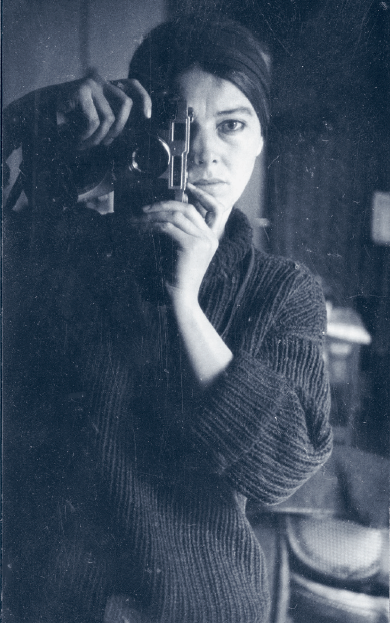
Maurer Dóra: Selfportrait, 1961 or 1962 © Maurer Dóra
How did you come by your scholarship to Vienna?
By having a solo exhibition in Vienna in ‘66. During my second trip to Vienna, the director of the Albertina bought two or three of my etchings and recommended me to the international artists’ club that operated in the city centre, in the Palais Pálffy, not far from the Albertina. I presented my works there and, on the recommendation of Peter Baum – who at that time was still an art writer – I was invited to do an exhibition. The lady who led the club later became the general secretary of Künstlerhaus, and she was also handling the scholarships that were intended for Eastern European artists. In my case, this was a Rockefeller Scholarship, which had previously been given to well-known Slovak sculptor Jozef Jankovič. I went to Vienna in the autumn of ‘67. Before I left, I was summoned to the Ministry by Comrade Boros, in order to warn me: if I am approached in any suspicious way – for the purposes of spying, for instance – I should report it immediately.
And were you approached?
No, I wasn’t. But it was in Vienna that I met Tibor.
This interview took place on 4 April 2014, in Dóra Maurer’s home. Interviewer: Tünde Topor. Video: Marcell Esterházy.
Thanks are due to her interns Katarina Bódiová, Reka Dankó, Anna Surján and Zsuzsanna Zsuró for typing up the transcript of the interview.
The full video can be viewed on Artmagazin Online.
Translated by Zsófia Rudnay
